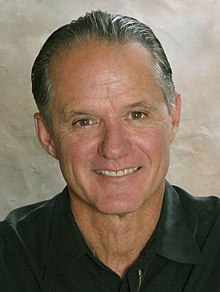Richard Strozzi-Heckler | |
|---|---|
 | |
| Born | 1944 (age 79–80) |
| Nationality | American |
| Alma mater | San Diego State University Saybrook University |
| Organization | Strozzi Institute |
| Known for | somatics, leadership development, psychology, aikido |
| Website | strozziinstitute.com |
Richard Strozzi-Heckler (born in 1944) is an American author, coach, and consultant on "embodied leadership and mastery."[1]
He is the founder of the Strozzi Institute,[2] headquartered in Oakland, California.[3]
Strozzi-Heckler spent his early life in a military family, periodically moving to different naval bases. In early adolescence, he began studying martial arts,[1] beginning with judo, then karate, and jiujitsu.[4] He excelled in athletics while in high school and was awarded a scholarship to San Diego State College in San Diego, California where he was named All-American in track and field.[5]
After a Marine Corps tour of duty in the mid-1960s, Strozzi-Heckler traveled throughout Asia studying yoga and meditation.[4] He returned to the United States, eventually earning a Ph.D. in clinical psychology from Saybrook University with an emphasis on mind-body connection.[5][6]
Strozzi-Heckler holds the rank of seventh-degree black belt in Aikido.[7] In January 2020, he was awarded Shihan by the International Aikido Headquarters in Tokyo, Japan.[8]
Strozzi-Heckler co-founded the Lomi School in 1970 with Robert K. Hall, Alyssa Hall, and Catherine Flaxman, integrating aikido[5] and bodywork principles into a body-oriented psychotherapy called Lomi Work.[9]
In 1976, Strozzi-Heckler, together with George Leonard and Wendy Palmer, established the Aikido of Tamalpais dojo in Mill Valley, California.[5] In 1985, he was invited to contribute to a US Army Special Forces project designed to test the effectiveness of integrating various practices into its training program. During the six-month program, he taught aikido and meditation techniques.[4]
In 1986, he moved to rural Sonoma County, California outside of Petaluma,[5] and developed a methodology, Strozzi Somatics, aimed at reproducing the outcomes of the US Army project with individuals and civilian organizations.[10]
Strozzi-Heckler helped design and implement the Marine Corps Martial Arts Program.[4][11]
Pointing out the relationship of thoughts and mood to an individual's body (e.g., posture, facial expression, tone of voice),[12] Strozzi-Heckler has said that congruency between these elements and a person's words is a primary characteristic of effective leaders.[7] He asserts that this characteristic can be practiced and improved as reliably as practicing and improving one's skill in a martial art or with a musical instrument.[5]
The Strozzi Somatics methodology involves eliciting an individual or organization's defining values and introducing practices that combine conceptual understanding with physical activity in a way that is intended to produce an increase in behavioral traits that are in accordance with those values.[4] Many of these practices are based on aikido movements or principles.[4][5]
In addition to corporate and military leadership, Strozzi Somatics have been applied to law enforcement, corrections, professional and Olympic athletics,[4] education, politics, social justice, and health.[1]